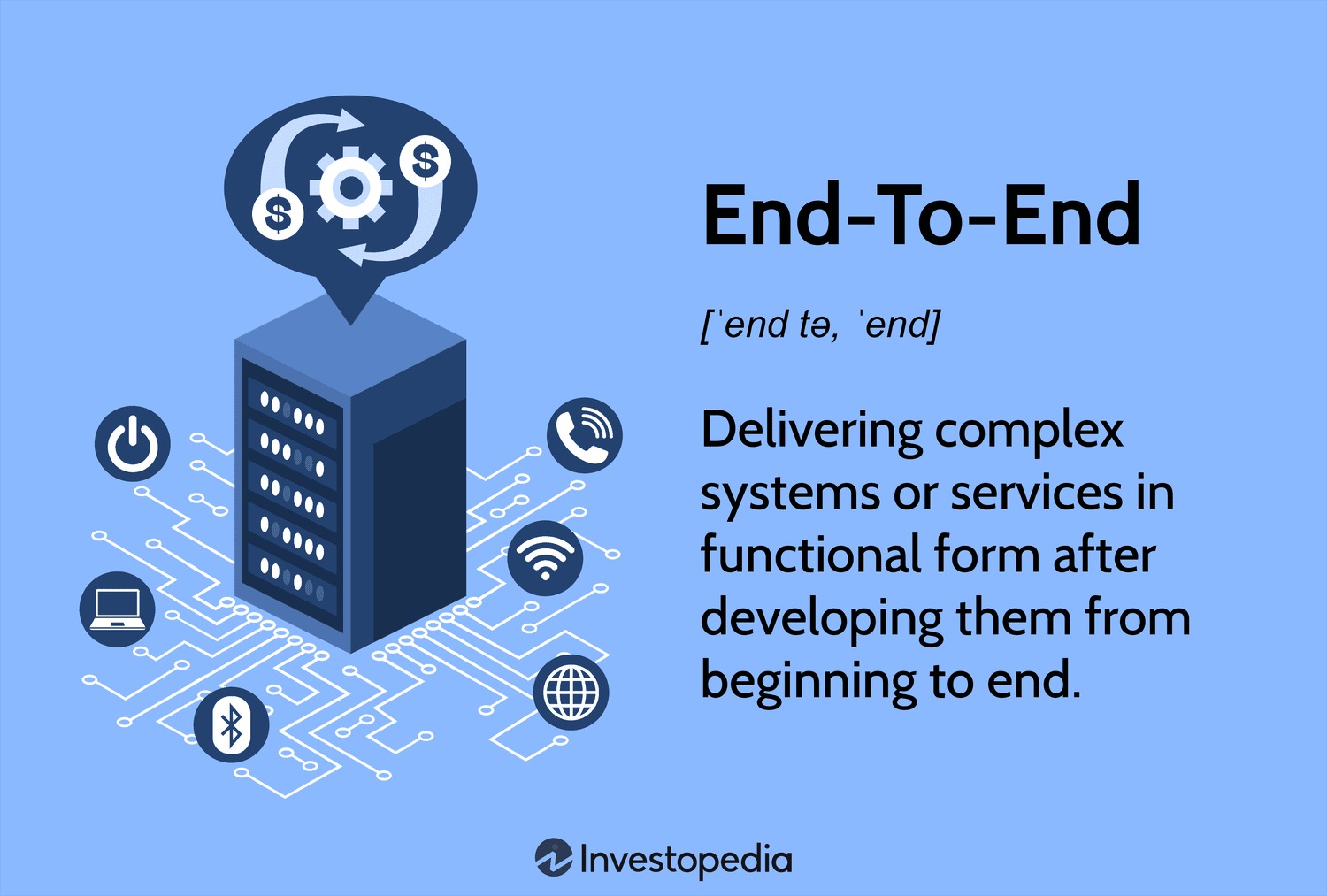 News
News
Outsourcing end-to-end development is not just about saving time or accessing more talent. It’s about handing over the entire software lifecycle to a partner who takes ownership from planning to launch and beyond. This isn't just execution. It's alignment, adaptability, and shared accountability that fuel better outcomes. Done right, it brings more than just code. It brings momentum, structure, and continuous product evolution. In this post, we’ll dig into the deeper reasons why outsourcing the full development cycle works, and the security essentials that make it a long-term asset, not a risk.
The Real End-to-end Development Outsourcing Key Reasons
Holistic Risk Sharing That Fosters Adaptive Innovation.
When you outsource entire development cycles, you're not merely offloading tasks. You’re entering a shared stakeholder dynamic. That means your partner is incentivized to navigate project pitfalls alongside you, proactively investing in contingency plans, governance processes, and QA frameworks. This kind of co-ownership encourages agility. If a technical bottleneck arises, their commitment ensures the problem gets immediate attention instead of just becoming another ticket in your inbox.
Embedded Innovation via Cross-Project Fluency.
Outsourcing firms frequently operate across diverse industries and project scopes, from fintech and eCommerce to logistics and IoT. This broad exposure allows them to internalize innovation patterns and bring those insights into your build. What you receive is not siloed code but a solution that benefits from ideas shaped by different markets. You get structural intelligence baked into your product, not just surface-level development.
Mastery over Modern Toolchains Without the Version Debt.
Keeping up with CI/CD pipelines, cloud-native orchestration, security frameworks, and scalable testing environments is not just about tools; it’s about the cost of staying current. Outsourced teams already work with the latest toolchains and upgrade them regularly. That gives you access to cutting-edge infrastructure like containerization and automated deployments without taking on the technical debt of maintaining them yourself.
True End-to-End Agility via Integrated Delivery Practice.
When the same partner handles everything from UX research to final deployment, internal coordination becomes seamless. Teams work within consistent agile and DevOps rhythms, with smooth handoffs and established sprint cadences. You don’t have to spend energy managing silos between design, development, testing, and operations. The entire process becomes one continuous feedback loop with fewer delays and more predictable progress.
Strategic Outcome-Oriented Partnerships.
Modern outsourcing models are evolving from transactional pricing to outcome-based structures. That means the vendor is aligned with your long-term success, not just short-term delivery. These partnerships shift the focus from timelines and ticket counts to performance, adoption, and product value. The more your product grows and succeeds, the more your outsourced partner benefits too.
Dynamic Capacity Calibration on Demand.
Project needs rarely stay flat. Whether you're scaling quickly after product-market fit or navigating a feature-heavy sprint, outsourcing lets you expand or shrink capacity with control. You don’t need to hire full-time staff or maintain an idle team during quieter phases. The model supports you with precise effort based on current needs, without long-term staffing constraints.
Elevating Through Automated Parallel Development.
Experienced outsourcing partners often break projects into modular parts that can be developed in parallel. This approach reduces coupling and speeds up delivery by enabling independent workstreams. As a result, features go live faster, scaling becomes easier, and maintenance is less risky. Over time, your software architecture benefits from better resilience and agility.
Sustained Support with Post-Launch Stewardship.
End-to-end doesn’t stop at launch. Many outsourcing partnerships include continued monitoring, patch management, and iterative improvements long after the initial go-live. The outsourced team stays engaged, evolving the product based on user feedback, performance trends, and emerging security needs. Your product doesn't go static; it matures with intention.
Intellectual Symbiosis That Builds Long-Term Advantage.
Long-term outsourcing partners absorb your product’s context deeply. They understand the business logic, user behaviors, and market pressures you deal with daily. Over time, this turns into a kind of shared institutional memory. Your partner stops being an external vendor and becomes a strategic contributor, offering proactive insights that align with your goals.
Security Tips for End-to-End Development Outsourcing That Actually Matter
➝ Vet Their Security Standards from the Start
Before signing any contract, go beyond general claims. Ask for concrete documentation of their security policies, internal audit schedules, and proof of certifications like ISO 27001 or SOC 2. Get clear explanations on how they handle encryption, data lifecycle management, incident response, and internal access rules. If the responses feel vague or rehearsed, that’s a red flag. This is the team you’re trusting with your product's architecture, customer data, and long-term technical roadmap, so surface-level answers won’t cut it.
➝ Demand Role-Based Access Across the Board
Every team member should only have access to the parts of the system relevant to their role. Developers should not be viewing production databases, and QA testers should not have administrative privileges on staging servers. The outsourcing partner must have clear role-based access policies and use proper identity management tools to enforce them. This reduces the attack surface and keeps sensitive areas tightly secured.
➝ Isolate Environments for Each Project
Outsourcing partners working with multiple clients need to separate project environments entirely. Your project should never share cloud infrastructure, databases, or staging environments with other clients. Ask them how they isolate development, testing, staging, and production for each project. Ideally, your environments are containerized, segmented, and individually secured to prevent accidental cross-project data exposure.
➝ Insist on DevSecOps, Not Just DevOps
Security cannot be a separate phase that comes in at the end of development. It needs to be part of every sprint from the beginning. Ask if they run vulnerability scans on third-party libraries, use static analysis tools on every commit, and monitor their CI/CD pipeline configurations for risks. The best teams use automation and secure coding practices daily, and they treat security as a core element of the build process rather than an afterthought.
➝ Encrypt Everything, Not Just the Obvious
Many teams are content with just using HTTPS and calling it secure. That is not enough. Insist on encryption for all data, including communication between services, stored backups, system logs, and application configurations. Ask how they handle key storage, key rotation, and algorithm updates. Encryption should be comprehensive and consistent, not selective or outdated.
➝ Conduct Joint Penetration Testing Cycles
Security testing should be collaborative. Even if the vendor claims they do regular penetration testing, make space for joint sessions where both your team and theirs review outcomes together. You can bring in third-party experts to validate the system’s security posture. These tests help expose real vulnerabilities and let both sides agree on mitigation strategies. Security is stronger when both teams are in the loop.
➝ Establish a Security Escalation Protocol
Security incidents are unpredictable, but your response should never be improvised. You need a documented protocol that clearly outlines what happens if there’s a breach. Define who gets notified first, what information is collected, how quickly action must be taken, and who is responsible for containment. Time is critical during incidents, and without a clear escalation plan, delays can amplify the damage.
➝ Monitor Their Subcontractors Too
Outsourcing firms often bring in external contributors for niche tasks, but these third parties can introduce major blind spots. Require full transparency on subcontractors and ask what controls are in place to vet them. Ensure that these contributors follow the same security protocols and are not given unrestricted access. Your agreement should allow you to audit or review their involvement if needed.
➝ Track Version Control Activity in Real Time
Your source code is not just intellectual property. It is the foundation of your entire business. Insist on tools that let you monitor version control activity as it happens. Every commit, pull request, and merge should be visible to you. Any skipped code reviews, unauthorized branches, or unusual patterns should trigger alerts. This keeps your codebase clean and protected from unauthorized or risky changes.
➝ Own the Infrastructure and Credentials
Even if the outsourced team sets up the infrastructure and manages your deployments, ownership must remain with you. You should be the admin on all cloud platforms, domain registrars, and code repositories. Keep access to master credentials, backup keys, and DNS settings. If the relationship ends or there is a crisis, you must have complete control over your systems without needing approval from an external team.
Why Partner with Blue Coding for End-to-End Development
Blue Coding manages projects and takes ownership of the entire software lifecycle. From the very first planning session to long-term post-launch support, our goal is to align with your business objectives and bring momentum to your digital products. We’ve built our reputation on delivering scalable solutions across industries like fintech, eCommerce, and logistics, while ensuring every project benefits from innovation patterns we’ve internalized through years of cross-market experience. What sets us apart is not just execution, but the adaptability and co-ownership we bring into every partnership. When you outsource with us, you gain a dedicated team that integrates seamlessly with your workflows, prioritizes security, and evolves your product continuously. If you’re ready to hand off your end-to-end development to a trusted partner, contact us today and let’s build something that lasts.




